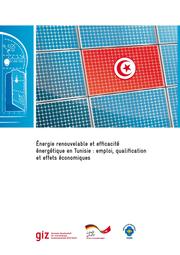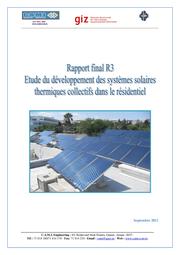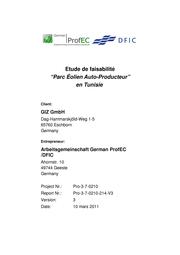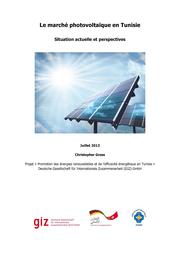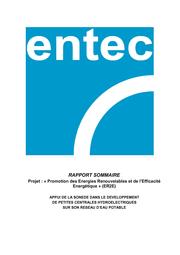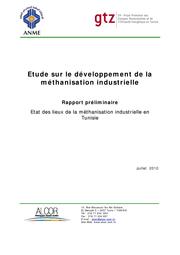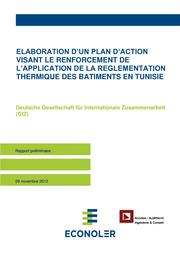Knowledge fuels change
For over a decade, Energypedia has shared free, reliable energy expertise with the world.
We’re now facing a serious funding gap.
Help keep this platform alive — your donation, big or small, truly matters!
Thank you for your support
Promotion of Renewable Energies and Energy Efficiency in Tunisia
Overview
Tunisia is heavily dependent on fossil fuels (oil, natural gas). Energy consumption increases by about 4% per year. The resulting greenhouse gas (GHG) emissions have harmful effects on the environment and the global climate. The competitiveness of Tunisian enterprises is affected by the energy intensity of the Tunisian economy. However, the potential of renewable energy (RE) and energy efficiency (EE) is still under-exploited.
In order to meet these challenges in the energy sector, the National Agency for Energy Conservation (ANME), a public institution under the supervision of the Ministry of Industry, was established in 1985 to ensure the implementation of a national policy in the field of energy management, including the promotion of energy efficiency and renewable energy.
In November 2003, the project “Promotion of Renewable Energy and Energy Efficiency” (ER2E) was initiated in the context of Tunisian-German cooperation to assist the ANME in developing appropriate approaches for energy management in Tunisia. The project is funded by the Federal Ministry for Economic Cooperation and Development (BMZ) and implemented by the Deutsche Gesellschaft für Internationale Zusammenarbeit (GIZ) and the ANME.
In the following you will find an overview about the different technologies and applications the project works on. Further information about the different subjects can be found in the studies conducted by ANME and GIZ-ER2E.
-> Find more information about the Tunisia Energy Situation
-> Download the Brochure of ER2E with information on project activities
Renewable Energies
During recent years, there has been an ongoing discussion which role renewable energies could and should play in the Tunisian energy mix. As in most countries, this question is discussed with different expectations and objectives which are typically covered by the energy-policy triangle and its three key challenges of cost-effectiveness, security of supply and environmental sustainibility. After the Tunisian revolution in January 2011, the political and economic constraints became even more important with
- conventional energy subsidies climbing at record levels, urging the government to increase energy prices
- rising energy demand and decreasing national gas ressources on the other hand
- Increased unemployment rate
Within this context, several studies were conducted by the project ER2E to provide input to the discussions on the future energy mix, socio-economic benefits of renewable energy and energy efficiency as well as the reform of the framework conditions for electricity production from renewable energy.
| «Etude Stratégique du Mix Energétique pour la Production d’Electricité en Tunisie », Wuppertal Institut/Alcor/GIZ (2012) |
« Renewable energy and energy efficiency in Tunisia – employment, qualification and economic effects », GWS/Alcor/GIZ (2012) |
«Analyse de la chaîne de valeur des technologies relatives à l’énergie solaire en Tunisie», Wuppertal Institut/adelphi/Ernst&Young/GIZ (2013) | «Analyse économique de l'introduction d'un système de tarif d'achat de l'énergie renouvelable en Tunisie», Meister Consultants Group/GIZ (2013) |
 |
|
coming soon |
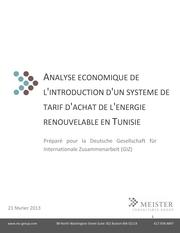 |
Solar Water Heater
The “PROSOL”-programme started in 2005 to revitalize the Tunisian solar water heater market. The financing scheme consists of a capital cost subsidy up to 55 Euros, provided by the Tunisian government, a loan mechanism for domestic customers to purchase SWHs, paid back through the electricity bill and discounted rates on the loans. The suppliers, who act as indirect lenders for their customers, must be accredited by the Tunisian Energy Agency (ANME). Clients eligible for PROSOL must have an electricity service contract with the Tunisian Electricity and Gas Company (STEG). The “Collective Prosol Programme” in Tunisia, a subsidy programme for solar thermal installations in the tertiary sector, started back in 2007. The application rate was low first, but then the commercial solar thermal market gained certain momentum. ANME designed the financial scheme in cooperation with the United Nations Environment Programme (UNEP) in 2008. The programme aimed at the installation of 60,000 m2 of collector surface in the tertiary sector between 2008 and 2011, including 80 hotels. This aim has been missed by far at the end of 2011. The main great achievement of the PROSOL programme has been to succeed in shifting a cashbased market to a credit-based market reducing the weight of such investment on the purchasing power of the population. According to estimates made by ANME, solar thermal technology for water heating could satisfy 70% to 80% of the water heating needs in the residential sector. As of end of 2012, a total of 490.000 m2 have been installed since the introduction of the "PROSOL"-programme in the residential sector for domestic hot water purposes. These SWH are thermosiphon systems with mainly flatplate and some evacuated tube collectors. The number of SWH companies eligible within Prosol has reached 47 by the end of 2010. By the same time, 1,042 installers were active in the market.[1]
Detailed analysis on the SWH market in Tunisia can be found in:
"Le marché solaire thérmique en Tunisie, Situation actuelle et perspectives" (2013), C.Gross/GIZ (en francais) (coming soon)
More information about SWH for apartment buildings in Tunisia can be downloaded here ("Etude du développement des systèmes solaires thermiques collectifs dans le résidentiel", 2011, CAMI):
Wind Energy
STEG began developing wind power in the early 2000s by implementing an initial capacity of 10 MW in Sidi Daoud in 2001, which was extended to 20 MW in 2003 and 55 MW in 2008. With the comissioning of the new wind farms of Kchabta (average windspeed of 8.9 m/s) and Metline (9.5 m/s) near to Bizerte, the total installed capacity reached 245 MW in 2012.
Tunisia has very interesting wind power potential estimated at around 8,000 MW and with wind sites showing more than 3000 full load hours. In the scope of promoting wind energy in Tunisia, and implementing the government's renewable energy policy, a Wind Atlas for Tunisia was established in 2009. It provides data on wind resources in Tunisia and identifies the potential by region. Measurements were made at 20 and 40m. The atlas is presented in GIS format (Geographic Information System) and data overlays are available in 10m, 60m, 80m and 100m. It shows that there are good wind conditions (speed exceeding 7m/s at 60m hight) in the regions of Bizerte and Nabeul, in the central regions (Kasserine) and in the southern regions (Tataouine, Western Cape, Gabes, Kebili). The realization of the atlas required the development of wind measuring masts in 17 different sites, and the use of statistics and data from the National Institute of Meteorology. Funding was supported by the Spanish Agency of International Cooperation for Development, AECID, CENER and the Community of Navarre, in partnership with ANME.
Within the objective to reach 30% contribution of renewables in the electricity generation mix of 2030, wind power is supposed to contribute 15% to the overall electricity mix. Depending on the different demand scenarios, this would correspond to an installed wind power capacity of around 1,5 to 2,5 GW in 2030. Determining factors for the future development of this sector in Tunisia include the opening of the electricity market to private investors and the possibilities for exporting wind power to Europe.
For more information about wind energy in Tunisia, see:
|
|
|
- Feasibility study for a wind parc within the autoproduction framework, German ProfEC/DFIC/GIZ, 2011 (in french)
|
|
Photovoltaics
So far, only approximately 3,5 MWp of PV systems on roof-tops have been installed (2013). Tunisia is currently revising its Solar Plan with the goal of accelerating the development of renewables, including PV, and facilitating legal procedures. In addition, decisions on the future electricity mix for Tunisia are expected for the coming months, which may result in a 10% PV share in electricity production until 2030, resulting in 1,5 to 2 GWp of installed PV capacity. To foster the PV development in the residential sector, the PROSOL-ELEC programme has been initiated by ANME in 2010. This includes a grant from the National Fund for Energy Conservation (FNME) representing 30% of the investment costs of the PV system and a ceiling of 2,300 TND per kWp. Further incentives include the provision of a credit for the PV system.
The self-production scheme, dedicated to the tertiary and industrial sector, has so far not been successful at developing PV projects. Overall the market for photovoltaics is still poorly developed and has only focused on small-scale residential systems. Photovoltaic plants of commercial scale (up to 1 MWp) and large-scale (more than 1 MWp) have not yet been realized in Tunisia.
Although international prices for residential photovoltaic systems dropped by 40 percent since 2010, prices in Tunisia have only decreased by 27 percent over the same period. Average price levels are still 25 percent above international levels. Lack of competition and transparency lead to market distortions and price variations in the range of 50 percent per system installed. In 2012, only 4 of 41 suppliers offered system prices close to international levels.
For detailed analysis on the Tunisian photovoltaic market, see:
|
The study identifies three market segments – Residential, Commercial, and Industrial – where photovoltaic systems in a net-metering scheme are already profitable or will be profitable in the near future. Without subsidies, residential roof-top struggles the most in being competitive with electricity rates that most consumers are obliged to pay. However, assuming access to international market prices and efficient capital state subsidies, residential systems become cost-effective. Where households consume more than 300 kWh per month, photovoltaic is already economically viable - even without subsidies. The same holds true for the commercial segment, where photovoltaic systems can provide savings in the range of 6-7 DT / kWh. Whether investments in the industrial segment are cost effective highly depends on the tariff structure, but the current situation shows promise for electricity produced during peak periods.
|
Concentrating Solar Power
Concentrating Solar Power (CSP) plays so far no role in Tunisia. A 50 MW parabolic trough plant is currently planned by STEG with financing from an international consortium. Within the preliminary energy mix objectives for 2030, an overall installed CSP capacity of between 400 and 600 MW is foreseen. Despite the advantage of the possibility of CSP plants to even store the thermal energy and afterwards produce the electricity when it is used, e.g. during night time, the technology is facing considerable problems due to its relatively high required investment costs and rapidly falling prices of other renewable energy technologies.
Small Scale Hydro Generation
The Tunisian public water supplier SONEDE (Société Nationale d’Exploitation et de Distribution de l’Eau) has some 1300 water pumping stations. Electricity consumption of the pumping stations is substantial with the biggest stations consuming more than 1 GWh of electricity per year. Likewise, the drinking water network has substantial potential for generating electricity by using the excess of pressure in the network system.
More information about small scale hydro generation potentials within the SONEDE network can be found in the study "Appui de la SONEDE dans le developpement de petites centrales hydroéléctriques sur son résau d'eau potable", entec/GIZ (2012)
Biomass
Although Tunisia disposes of significant biomass resources, energetic use of biomass is today mainly seen for cooking purposes in rural areas and some industries.
However the quantity and quality of organic material (e.g. sewage sludge, animal excrements, residues from olive oil production) would allow for a significant production of (storable) biogas, which than can be transformed to electricity or used for thermal or other applications.
Detailed information on the potential of the different organic materials in Tunisia, can be found in:
"Etude sur le développement de la méthanisation industrielle en Tunisie", Alcor/GIZ (2010)
Energy Efficiency
Energy Efficiency in the Industry
The industry sector of Tunisia accounts today for about 36% of final energy consumption. More than 50% of this consumption comes from the production of construction materials like e.g. cement and brick.
Institutional activities, which generally include initiatives based on auditing and programme contracts, are the cornerstone of Tunisia’s policy for the rational use of energy. These programmes aim to strengthen the commitment of public and private economic operators in the field of energy efficiency. The 2004 regulatory framework bolstered this activity with the organisation and promotion of investments to improve energy efficiency in businesses.
During the 2005-2010 period, over 420 energy audits were carried out in various industrial, tertiary and transportation sectors, over 50% more than the number of audits conducted during the 1987-2003 period. Between 2005 and 2010, 651 programme contracts were established, representing a total investment of TND 239 million.
From the supply-side perspective, energy audits are carried out by expert auditors from consultancy firms or by engineering consultants, certified by ANME. The number of expert auditors has risen sharply over the last five years, with 152 experts as of end 2010.
In order to complete programme contract projects, expert assistance is increasingly required to help companies implement their energy savings objectives.
Detailed information can be found on the web page of the program for the promotion of energy efficiency in the industry sector of ANME [2]
Energy Efficiency in Buildings
The building sector, notably the residential building sector, showed strong growth during recent years. Energy efficiency measures like thermal insulation, shading, double-glazed windows etc. offer huge potential with relatively high cost-efficiency.
ANME's energy efficiency programme for buildings aims to improve the thermal performance of residential and tertiary sector buildings, by developing energy performance regulations suited to the climate context in Tunisia.
The purpose of these regulations is to define the minimal standards to be applied for the design and construction of residential and tertiary sector buildings by:
- developing minimum technical energy-saving specifications for projects to construct or extend office buildings and multi-family residential buildings;
- establishing blueprint auditing for new projects and extension projects;
- defining conditions and methods for carrying out blueprint energy audits in the residential and tertiary sectors.
Although the regulatory framework provides for access to benefits and subsidies in accordance with national efforts in favour of energy management, achievements are still somewhat limited, with around 12 blueprint audits and 12 signed programme contracts, representing a total investment of around 0.6 million dinars.
For further information, see:
Cogeneration
Cogeneration development in Tunisia was launched in 2001, with the publication of the December 2002 decree (2002- 3232) establishing rules and provisions for the implementation of cogeneration projects. Despite the high potential of around 600 MW estimated by ANME (430 MW in the industrial sector and 170 MW in the tertiary sector), the established objectives have yet to be attained. As of end 2012, total installed capacity was around 36 MW with a yearly production of 236 GWh.
Further Information
References
- ↑ "Etude du développement des systèmes solaires thermiques collectifs dans le résidentiel", 2011, CAMI
- ↑ http://www.peei-industrie.net/

